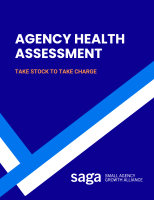With apologies to my human resources friends, I don’t like Performance Improvement Plans (PIPs).
It’s not that I don’t believe that you have a responsibility as an agency owner to manage the performance of your team and communicate with them where they are doing well and where they need to improve. That’s absolutely essential.
But it should be taking place in the course of your weekly 1:1 meetings and is an ongoing process.
If you need to call performance out to the degree that you are putting an employee on a PIP, it is probably already too late.
Over the course of more than 25 years as a manager and consultant, I cannot recall a single instance in which an employee who was put on a PIP managed to turn themselves around. That experience spans organizations of many different sizes with managers and employees of all different kinds of backgrounds.
What’s wrong with PIPs?
Here’s why most Performance Improvement Plans don’t work:
- The manager’s mind is usually already made up. By the time a manager sits down and talks with an employee about putting them on a performance improvement plan, they have usually already reached a point of frustration where what they really want to do is fire the individual. (And if what you really want to do is let that person go, make everyone’s life simpler by just doing it.)
- The employee has been underperforming too long to change easily. A PIP is all about getting an employee to change things that have likely become habits (if they weren’t already when they were hired). In the relatively short timespan of these plans, it is very difficult to break the cycle.
- Most performance problems aren’t narrowly focused. Think about the underperforming employees you have seen over the years. If their shortcoming is something simple like they don’t show up on time, but otherwise do a great job, that’s something that can be fixed. Usually without a PIP. Unfortunately, most PIPs end up being very general or try to address too many issues in too short a time.
- A PIP is demoralizing to the employee. Telling someone “do this or else” isn’t the best way to help build them up. Many low performing employees often lack confidence or a positive attitude anyway, so anything that reinforces those issues is unlikely to solve others.
- Most plans focus only on the individual employee. A low performer doesn’t exist in isolation. Their lack of performance is a result of the initial hiring decision, how they are managed, and how the rest of the team interacts with them. Yet most PIPs depend on the employee alone making changes. True performance improvement requires a team effort.
Should a PIP ever be used?
There may be a limited number of circumstances in which you might consider a Performance Improvement Plan, despite the shortcomings that I have identified.
Any time you are considering terminating an employee, it is a good idea to check with your HR consultant or employment lawyer to ensure that there aren’t any red flags that require special handling.
If your advisers do identify potential issues, a PIP can be a tool to demonstrate that you bent over backwards and provided the employee with every opportunity to address the concerns that you clearly documented. That can make an eventual termination go more smoothly as long as it is a good-faith effort on your part to make it work.
Beyond the potential legal considerations, you may want to use a PIP to soothe your conscience. Letting an employee go isn’t easy for most agency owners, so you may need to use the PIP to help you get over the hurdle of deciding to end the employment relationship.
In that case, you should probably view the period of the PIP more like “garden leave” where you understand that you are paying the employee for a limited amount of work on a glide path to departure.
It can also give you time to search for a replacement while you still have the seat occupied and presumably absorbing at least some amount of work from the rest of your team.
What you should do instead
Just because I don’t think that Performance Improvement Plans work doesn’t mean that you shouldn’t have plans to improve performance.
The foundation of strong employee performance is good communication, so you should be using your weekly 1:1 sessions with your direct reports to provide constructive feedback on what’s working and what isn’t.
The individual needs to drive the solutions, however. Together you will identify the issue, the cause, and the solution. If this is a top-down, manager-driven process it won’t likely work.
Remember that your role as a manager isn’t to simply delegate and hold your employees accountable for those tasks. Your more important function is to serve as a coach, mentor, guide, and facilitator.
Think of yourself as a blocking back (to use an American football analogy). You need to help clear a path for your employee to give you peak performance. Find out from them what obstacles may be holding them back. It could be knowledge, training, feedback, cooperation, or something else.
The important thing to understand is that no employee can improve their performance on their own. They will need active support from you and their colleagues. It may even require an investment in training or support if you really want it to work.
If you have strong lines of communication, a willingness to support performance improvement, and the ability to address small problems before they become large ones, you can get the same results without the headaches and bureaucracy that PIPs introduce.










